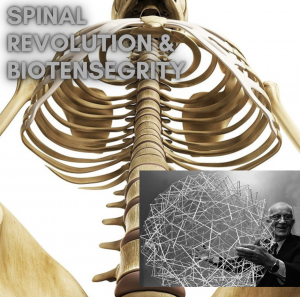Online – Spinal Revolution and biotensegrity anatomy workshop
Tensegrity models are key because their physical behaviour is similar to living tissues in many ways. Bio means life, so adding human emotion, experience and character behind every move gives a different perspective on the tissues. Biotensegrity is different because it examines the basic rules of physics first and recognises that everything else must be derived from them, thus representing a paradigm shift in the way that we think about the human body. Our workshop looks at the whole body in relation to the spine, thus showing that interconnectedness between every part of the organism is essential to generate a proper understanding of its functions and health.

The question for movement therapists is where to start. Remember one size does not fit all. We are all different and each persons conditioning, architecture and structure is in accordance with their belief system, interests, preferences and inclinations. We must not forget that we are ultimately dealing with biology, where no one aspect can be fully understood without an appreciation of all the others. Biotensegrity is personal to each person.We are holistic human beings because the nature of connective tissues is that it maintains separation as much as it creates connection. “Everything in nature has its own vibrational frequency and elastic quality and biotensegrity represents the dynamic reciprocal elasticity inherent to life” Satya Sardonicus, DC, CACCP. This course looks at body mapping and movement in relation to spinal pathologies. We also look also at tension – compression, pressure – spacing, gravity and fluidity, reaction and response. Joints, connective tissue and discs may contribute to the pain symptoms in clients. We will look at the fluidity and elasticity of movement to help this.
The thoracic spine is built for rotation, flexion, and extension. It is highly mobile – or, rather, it has the potential for lots of mobility. Because of its mobility, the thoracic spine must be used, and it must be moved. But it has to be understood that emotions such as anger, frustration, sadness and bitterness travel through the fascial web making imprints every step of the way . If people are unable to visualize and feel the movement of the thoracic spine, or if they’re unable to even grasp the concept of its existence, they’ll just attempt to twist, rotate, flex, and bend with something familiar to them: the lumbar spine – and that’s bad news! This is a movement system that gently works the entire body, opening energy pathways through rhythmic, spiralling movements.

What they said:
“Lots of information regarding why people have lower back pain. Struggled a little bit with anatomical terms. Really enjoyed the work on the reformer and the thoracic decompression excerpts. Great ideas to work with ‘real’ clients. Lots of tests to try with clients – good feedback. Learnt that I have a lot of spinal issues myself and need to take time before I do some 1 to 1s with Nisha!”
“Clearer about spinal conditions and tightness and how I can help the client release. By the end I felt a bit overwhelmed with the amount of information, it’s made me question what I know and teach regularly as well as give me confidence in my own self when something in the back of my mind says ‘but’ or ‘hang on, is that right?”
“Absolutely essential for yoga / pilates teachers – so much information in a format that can be used immediately. The group size is excellent, excellent value for money.”
“Can’t wait to show this work”.
“Great course, love the teaching style – great keep putting theory into practice. I really feel I have learnt loads today and looking forward to using it in my own practice.”
What you will learn:

This workshop is open to Yoga/Pilates teachers, Movement/Manual therapists, Physios, Chiropractors, Osteopaths and weekend warriors.
